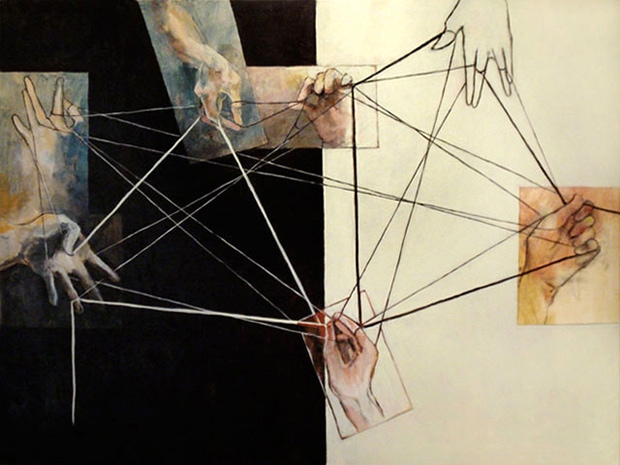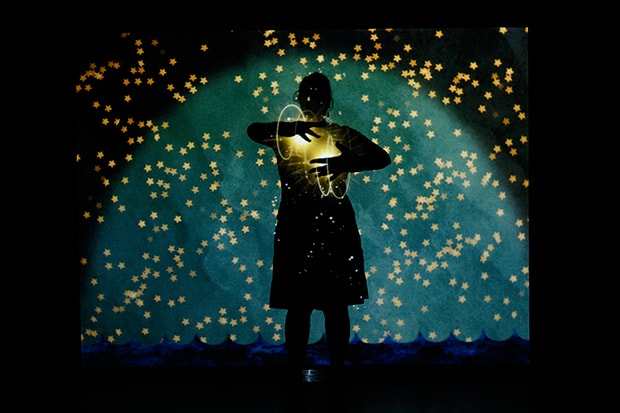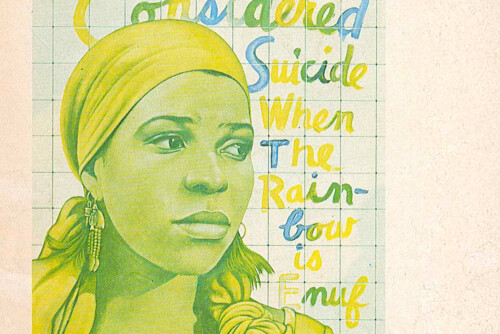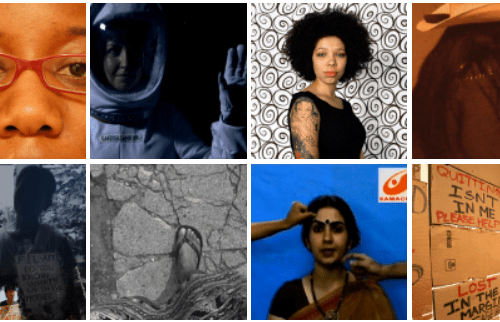Haraway. Star: Relays and Boundary Objects

In 2011 feminist technoscience theorist Donna Haraway was presented with the Pilgrim Award for lifetime achievement in the field of scholarly SF (science fiction) by the Science Fiction Research Association. Science fiction and speculative feminisms became companion species through this event, and Haraway worked this connection carefully in her acceptance speech, “SF: Science Fiction, Speculative Fabulation, String Figures, So Far.” The game of cat’s cradle, a story arc across a range of transmedia Haraway episodes, comes into its own here, pictured, described, metacommunicated, performed, extended or “relayed,” as a collective and collaborative practice of worlding:
These knowledge-making and world-making fields inform a craft that for me is relentlessly replete with organic and inorganic critters and stories, in their thick material and narrative tissues. The tight coupling of writing and research—where both terms require the factual, fictional, and fabulated; where both terms are materialized in fiction and scholarship—seems to me to be built into SF’s techno-organic, polyglot, polymorphic wiring diagrams. My multispecies story telling is inflected through SF in all the fibers of the string figures that I try to pattern and to relay.1
Those perceiving multiform contributions to SF from Haraway cannot be wedded to only intensive definitions of “the field.” Feminist speculative fabulation is an extensive category, perpendicular but necessary to the skills of defamiliarization shaped by fandoms with crafty-cares: world-crafting as well as drawing; role playing; gaming; writing; critiquing; reviewing; costuming; songwriting and singing; webby community building; techy arts and communications—fans advocating their interests in film, TV, and other media and culture industries, shaping environments and contexts for imagination and cognition. True, fans, some of them writers and scholars, may hotly promote their own detailed and careful definitions of what counts as science fiction or fantasy and their various subgenres and communities of practice: those intensive disciplines of detail, membership, and gatekeeping, those oxytocin-fueled edges of bonding and othering. But including Haraway’s contributions to SF takes place extensively—in generous “relays” of patterning, attention, wonderings, rewarded by dopamine spikes producing and triggered by pleasure, anticipation, yawning fields for memory, learning and unlearning, as well as tenacious addictive repetitions.
Relays, cat’s cradle, passing patterns back and forth, giving and receiving, patterning, holding the unasked-for pattern in one’s hands, response-ability, Octavia Butler’s Patternmaster series. My debts mount. Again and again, SF has given me the ideas, the stories, and the shapes with which I think ideas, shapes, and stories in feminist theory and science studies.2
Relaying is relative and relational, reciprocal and enheartening—enjoying the celebrity of one that promotes pleasures in many networking together. Worlding is a practice of displaying as well as crafting worlds, of sharing as well as enjoying expertise, of noticing tiny details of connection and similarity amid the tweaks and frissons of alternative shadings across many intertexualities of association, history, genre, care.
In August 2010 in the Santa Cruz mountains, Haraway attended a celebration of the life of her compatriot in speculative fabulation, Susan Leigh Star, whose unexpected death in March had reverberated across many feminist, science-studies, and spiriting worlds. Star’s last essay was a bit of retrospection about as well as relaying on a conceptual tool she had become known for. In this last essay, Star reflected on her notion of boundary objects as itself a boundary object; clarifying its origins and uses, she still refused to authoritatively standardize it, even while recognizing that many boundary objects over time do enter into processes of standardization, even cycling around residual categories, methods, standards, and infrastructures. Holding the notion of a boundary object at this point in which no single agency is authorized to stabilize it, she remarked on its uses for those cooperating without consensus. There, groups tacitly “tack back-and-forth” between their own local groups who maintain an intensive, specific, tailored identity for important objects, and the workaround processes required to collaborate with other groups and their objects, divergently tailored, yet held extensively in common.3
Star refers to Bateson when she reflects on the origins of the concept of a boundary object:
As I delved deeper into the relations between developers and users, it became clear that a kind of communicative tangle was occurring. I used the work of Gregory Bateson, who had studied these sorts of communicative mishaps under the heading of “double binds.” As with Bateson’s work on schizophrenics, and what he called “the transcontextual syndrome,” the messages that were coming at level one from the systems developers were not being heard on that level by the users and vice versa. What was obvious to one was a mystery to another. What was trivial to one was a barrier to another. Yet, clarifying this was never easy. The users liked the interface when they were sat in front of it. Yet, they did not know how to make a reliable working infrastructure out of it. They would ask the … team, who would reply in terms alien to them. I began to see this as a problem of infrastructure–and its relative nature.4
At this point in its cycles, a boundary object can be used as a particular sort of worlding tool. Either tacitly or playfully, in a doubled or multiplied consciousness, it patterns back and forth across locals and globals in layers of intensity and detail. Growing such boundary objects could be perpendicularly perceived as more cat’s cradle games and relays. Star teaches us how to put feelers out for the frisson that signals misrecognition or anomaly—these then become wormholes across multiple social worlds, connected through transdisciplinary boundary objects.
Despret. Latour: Learning to be Affected
Several times I had to contact interlibrary loan to score electronic copies of the two papers from a journal my university did not subscribe to. Donna Haraway recommended one in particular to me as I worked on my own paper for SLSA (the Society for the Study of Literature, Science, and the Arts). I was trying to work out what might matter about training an artificial-intelligence agent, packaged as a “dog,” to herd “sheep” in the virtual world Second Life. Whether Second Life is a “game,” or not, is sometimes hotly debated among its residents or among self-described gamers. Why should I, or anyone else, care about this play? Haraway, once my dissertation director, relayed me to the work of philosopher and psychologist Despret, a thinker my old undergraduate teacher Gregory Bateson would have loved.
My PhD is in the history of consciousness, a department title with a complicated history itself, and one often taken, rightly or wrongly, with a grain of salt—after all, what counts as “consciousness” such that it can have one or more histories? I had been delightfully scooped up for a 2009 panel on Tranimals by other HistCon types and Haraway advisees Lindsay Kelley and Eva Hayward. The cat’s cradle game that is HistCon is an ongoing generational relay connecting, among many others, Bateson, Haraway, King, Hayward, and Kelley, in many possible configurations of interactive play.
Should I wait for the 2004 essays from interlibrary loan? I could use the draft version of the other one, Bruno Latour’s, that had been online since 1999, and the original symposium in Paris from which the special issue of Body & Society had derived. But the disclaimer on his website was daunting: “Warning: those texts are made available for private academic use only; there might be huge differences between this version and the final published one, especially concerning footnotes; always report to the author and publisher for any other use.” For an oral presentation only, I might have blown this off. But I was creating a “talksite” on Blogger for this one. How did that matter? And how might all these infrastructures—of publication, media, conferences, scholarly communication, research results and processes—matter too? Were they only background for the real stuff? Or are they among the actual materialities of distributed thinking?
Despret is another great ethological fabulist and the essay, “The Body We Care For: Figures of Anthropo-zoo-genesis,” is a set of multiple retellings of old stories, ones with iconic status in the histories of research methods. The very first science fiction here, the one about the so-called “Clever Hans effect,” starts the essay off as a challenge to the elegant parsimonies of explanation, accuracy, and rigor characterizing “best practices” in laboratory or field psychology in the twentieth century. Rather than a debunking tale, where a famous horse is cleverly revealed to only appear to do mathematical calculations, actually instead “merely” reading the reactions of the humans around him, Despret’s retold story turns out to be about clever bodies and things, which, at the very edge of apprehension, attune themselves to one another: an interactive agency we can call “learning to be affected.”5

Relaying this story and adding his own patterns of meaning to it, Bruno Latour, one of the architects of so-called actor-network theory in the social studies of science, uses the idea to describe what happens when a perfume expert learns to become a “nose” (in the parlance of the trade), that is, learns to distinguish very subtle ranges of smell by training with an “odor kit,” a device organized in a careful palette of small differences. Learning to be affected here entails “a dynamic trajectory by which we learn to register and become sensitive to what the world is made of.”6 Bodies and things, processes and interactivities are all engaging together in the many possibilities across “learning to be affected.” New media infrastructures, boundary objects, and processes of learning also work across redistributed agencies, ones not located simply in the consciousness of individual humans in seeming control, but rather ones emergent across materialities of social media old and new, together with beings and economies and knowledge workers and neurobiological systems, affecting and being affected. “Thus body parts are progressively acquired at the same time that ‘world counter-parts’ are being registered in a new way. Acquiring a body is thus a progressive enterprise that produces at once a sensory medium and a sensitive world.”7
- Donna Haraway, “SF: Science Fiction, Speculative Fabulation, String Figures, So Far: The Pilgrim Award Speech,” delivered by DVD, Lublin, Poland, 7 July 2011. Video retrieved (m4v) 31 Aug 2011. [↩]
- Haraway 2011. [↩]
- Susan Leigh Star, “This is Not a Boundary Object: Reflections on the Origin of a Concept.” Science, Technology & Human Values 35.5 (2010): 614-15; 604-5. [↩]
- Star 2010: 610. [↩]
- Vinciane Despret, “The Body We Care for: Figures of Anthropo-zoo-genesis,” Body & Society 10.2-3 (2004): 113; 125; 131. [↩]
- Bruno Latour, “How to talk about the body? The normative dimension of science studies,” Body & Society 10.2-3 (2004): 206. [↩]
- Latour 2004: 207. [↩]





